In Harms Way
 Thursday, May 27, 2010 at 01:09AM
Thursday, May 27, 2010 at 01:09AM It is spring, and many animal species are giving birth, laying eggs, and raising their young. No matter how careful and watchful the parents and offspring are, it is still a risky business with no guarantee of survival. If we factor in the world of man and all our machines, road, technologies, environmental degradation and destruction, the risk to wildlife is ridiculously high in many instances.
Yesterday, as part of my job, I searched the grass and sand parking area that is just outside the technical boundary of the nature sanctuary. I was looking for the ground nests of Killdeer – birds which arrive each spring to lay their eggs in this flat open field. I had to locate the very well hidden nests and eggs because the field is part of an overflow parking area for the adjacent amusement park and would be utilized for the Memorial Day weekend crowds.
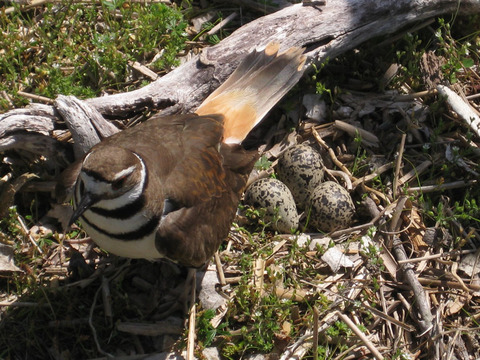 Killdeer and eggs at nest site. (Click to enlarge).Around each of the 7 nesting sites I pounded in wooden stakes and wrapped caution tape to deter lawnmowers, and to direct drivers and their cars away from the birds and their eggs. I had the pleasure of observing the beauty of these birds and their behavior up close. When I approached the nest, the mother Killdeer makes a lot of distress calls and fans out its feathers in a protective manner. In some cases, when the mother saw me approaching, she took off running along the ground making noise and faking a broken wing to distract my attention from her nest full of speckled eggs. Killdeer are noted for this diversionary tactic (click here to see video). It felt good to help protect these Killdeer and their eggs.
Killdeer and eggs at nest site. (Click to enlarge).Around each of the 7 nesting sites I pounded in wooden stakes and wrapped caution tape to deter lawnmowers, and to direct drivers and their cars away from the birds and their eggs. I had the pleasure of observing the beauty of these birds and their behavior up close. When I approached the nest, the mother Killdeer makes a lot of distress calls and fans out its feathers in a protective manner. In some cases, when the mother saw me approaching, she took off running along the ground making noise and faking a broken wing to distract my attention from her nest full of speckled eggs. Killdeer are noted for this diversionary tactic (click here to see video). It felt good to help protect these Killdeer and their eggs.
These are beautiful, sweet little birds in the Plover family of shore birds. Like the Sanderling sandpiper that honors the title page of this website, Killdeer run very fast on their long legs, and are just adorable creatures.
However, today presented a very different reality to me as I learned that for the Memorial Day weekend, the county has agreed to let the Marines stage a mock assault operation using four massive twin prop helicopters filled with combat soldiers in the spirit of honoring those who serve in our military. Fine. I'm all for honoring our troops past and present, and I am indeed mightily impressed with military expertise.
I'll give you but one guess as to where these assault troops and aircraft will be landing . . .
I spent the better part of the day trying to get accurate information regarding the logistics of the event and hoping to persuade officials to have the helicopters land away from the nesting birds. After much discussion with fellow naturalists and a wildlife rehabilitator on what to do, and with no chance of having a few tiny birds deter the Marines from landing, I came to the sad realization that the birds will be blown away – literally, eggs, nests and all. The force of the downdraft from the helicopters massive rotors will blast sticks and stones, flotsam and jetsam, birds and eggs clear off the field. The developing birds within their egg shells will have their first and last flight before they even hatch.
The only chance, which is not ideal, is to try and capture the birds and their eggs, putting them in boxes and removing them temporarily from the landing zone. Once the helicopters and Marines (and the general public) depart the field hours later, the birds will be replaced in the same nesting locations on the field. We can only hope that the parent birds feel okay after this insult and that they choose to reform the nest and accept the eggs for resumed incubation. The odds are not good, but we had to try something. None of us could bear to sit back and watch the destruction. (Click photos below for larger view).
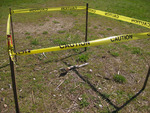
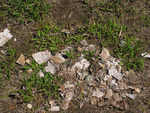
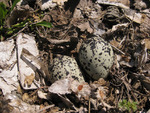 Walking slowly out to one of the nest sites, I sat down just three feet from the Killdeer guarding her eggs. It was about 90 degrees out there and she just stood still over her eggs shading them from the heat, quietly looking at me. She opened her mouth, breathing in and out to help cool down her body. We regarded one another for a few minutes – me with the dreadful knowledge of the future, and she with the powerful instincts passed down from many thousands of generations of Killdeer ancestors. She shifted a bit to look at me squarely as I began to talk to her, explaining the situation and apologizing. It wasn't that I expected the bird to understand a single word I said, but rather I felt a desire to connect in some way, transcending limitations imposed by our two species. Somehow I feel our spirits touched for a moment.
Walking slowly out to one of the nest sites, I sat down just three feet from the Killdeer guarding her eggs. It was about 90 degrees out there and she just stood still over her eggs shading them from the heat, quietly looking at me. She opened her mouth, breathing in and out to help cool down her body. We regarded one another for a few minutes – me with the dreadful knowledge of the future, and she with the powerful instincts passed down from many thousands of generations of Killdeer ancestors. She shifted a bit to look at me squarely as I began to talk to her, explaining the situation and apologizing. It wasn't that I expected the bird to understand a single word I said, but rather I felt a desire to connect in some way, transcending limitations imposed by our two species. Somehow I feel our spirits touched for a moment.
After a while I said goodbye to the bird and walked away. For now, I can only hope for the best as both she and I must await the coming assault. (Read part two of this story here.)
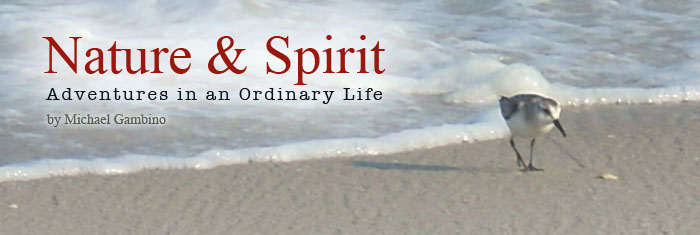
Reader Comments (5)
I hope everything went well. I am chronicling some killdeers around a local lake that is heavily used for outdoor activities, fishing, and fireworks. There are some killdeer in "protected" areas of the park where people can't follow, but most of them are where people walk around quite often. On the 4th of July, just about every inch of one or two of the males' breeding area will be covered by people. So far, they don't have any eggs, but I'm afraid they might have girlfriends and some eggs soon (females are taking an interest in them). I hope the park officials will let me put up tape around their nest likes you did so they don't get trampled if he has a nest by July 4th.
Hi Darlene,
It sounds like you have a Killdeer challenge of your own. Perhaps you can raise awareness and interest in the bird's situation by writing an article in the local paper? Or maybe the local cable TV station would do a piece to help protect the nests. It sounds like you have many more sites that need looking after. You could use some extra help. Perhaps volunteers from animal hospitals, or wildlife rehabilitator?
Constant use is a bigger challenge than my Killdeer faced since the area is not always in use by crowds. Just on certain summer holidays it is threatened. I wish you luck and hope you can help the birds. Since they are not an endangered or threatened species, some may say so what. But that is how many animals and plants got to be on the endangered species list.
Regards,
Michael
Thanks! I decided to try to try and do something if they do lay eggs before July 4th and it looks like a problem. The area is part of a large urban park and there are park officials and volunteers that can possibly help. I don't get to see that many killdeer chicks, lately, and I really want to see some, but I want them to be safe, too.
I'll be watching this space for an update from both Michael's batch and Darlene's. Good luck to you both and your little feathered friends. They should know how fortunate they are.
I didn't realize I never updated anyone on this. Strangely enough, two sets of chicks hatched on July 4th during the fireworks and all of them did exceptionally well. All chicks survived, grew up and now have grown chicks of their own that are old enough to be picking mates. Since then, I have seen other chicks grow up, but all have hatched well before the July 4th fireworks. I don't know why they don't breed around that time anymore, but I'm glad they are done by then.